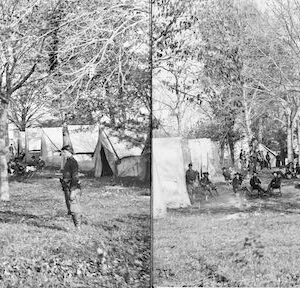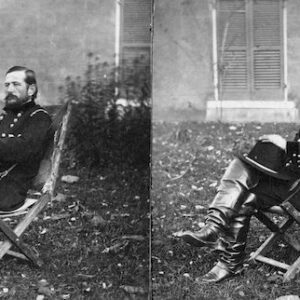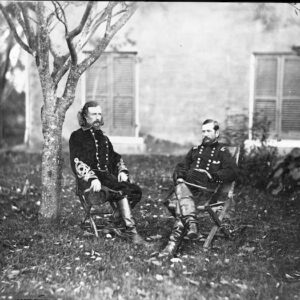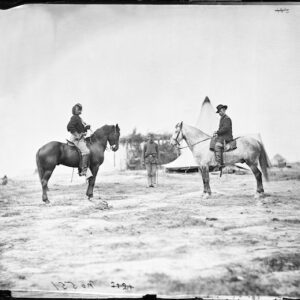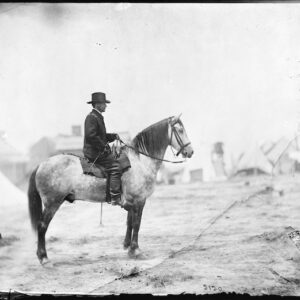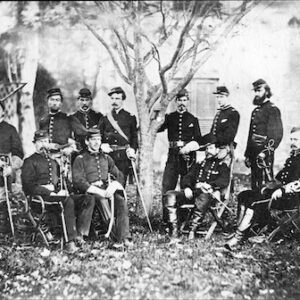Tag: Pleasonton (Alfred)
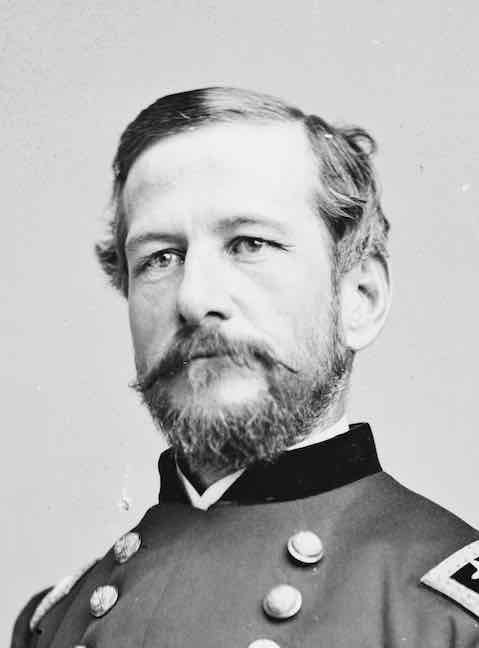 Wikipedia says: Alfred Pleasonton (July 7, 1824 – February 17, 1897) was a United States Army officer and major general of volunteers in the Union cavalry during the American Civil War. He commanded the Cavalry Corps of the Army of the Potomac during the Gettysburg Campaign, including the largest predominantly cavalry battle of the war, Brandy Station. In 1864, he was transferred to the Trans-Mississippi Theater, where he defeated Confederate General Sterling Price in two key battles, effectively ending the war in Missouri. He was the son of Stephen Pleasonton and younger brother of Augustus Pleasonton.
Wikipedia says: Alfred Pleasonton (July 7, 1824 – February 17, 1897) was a United States Army officer and major general of volunteers in the Union cavalry during the American Civil War. He commanded the Cavalry Corps of the Army of the Potomac during the Gettysburg Campaign, including the largest predominantly cavalry battle of the war, Brandy Station. In 1864, he was transferred to the Trans-Mississippi Theater, where he defeated Confederate General Sterling Price in two key battles, effectively ending the war in Missouri. He was the son of Stephen Pleasonton and younger brother of Augustus Pleasonton.
…At the start of the Civil War in 1861, Captain Pleasonton traveled with the 2nd Dragoons from Fort Crittenden, Utah Territory, to Washington D.C. Despite active politicking on his part, attempting to capitalize on the faded political connections of his father (who had died in 1855), Pleasonton did not earn the rapid promotions of some of his colleagues. He was transferred to the 2nd U.S. Cavalry Regiment on August 3, 1861. He was promoted to major on February 15, 1862. He fought without incident or prominence in the Peninsula Campaign, providing Army of the Potomac commander Major General George McClellan with little accurate or valuable information. On May 1, 1862, Pleasonton was nominated by President Abraham Lincoln for promotion to the grade of brigadier general of volunteers to rank from July 16, 1862, and the United States Senate confirmed the appointment on July 16, 1862. President Lincoln formally appointed Pleasonton to the grade on July 18, 1862. He then commanded a brigade of cavalry in the Army of the Potomac.
On September 2, 1862, Pleasonton assumed division command in the cavalry. He was wounded in the right ear by the concussion of an artillery shell at the Battle of Antietam on September 17. Ever ambitious, Pleasonton was displeased that he was not promoted to major general of volunteers for his actions, claiming erroneously that his division, and particularly the horse artillery assigned to him, had had a decisive effect on the battle. He did receive a brevet promotion to lieutenant colonel in the regular army, probably based solely on the inflated claims of his battle report, which were not substantiated by the reports of other generals.
At the Battle of Chancellorsville, Pleasonton continued his practice of self-promotion. He claimed that he temporarily halted an attack by Stonewall Jackson’s Corps and that he was able to prevent the total destruction of the Union XI Corps on May 2, 1863. He was persuasive enough that the commander of the Army of the Potomac, Maj. Gen. Joseph Hooker, told President Abraham Lincoln that Pleasonton “saved the Union Army” at Chancellorsville. Battle reports, however, indicate that Pleasonton’s role was considerably less important than he claimed, involving only a small detachment of Confederate infantry on Hazel Grove. Nevertheless, his claims earned him an appointment to the grade of major general of volunteers on and to rank from June 22, 1863, and when the inept Cavalry Corps commander, Maj. Gen. George Stoneman, was relieved after Chancellorsville, Hooker named Pleasonton as his temporary replacement. Pleasonton could not accept even this elevated role gracefully. He wrote to Gen. Hooker “I cannot…remain silent as to the unsatisfactory condition in which I find this corps…the responsibility of its present state…does not belong to mePleasonton’s first combat in his new role was a month later in the Gettysburg Campaign. He led Union cavalry forces in the Battle of Brandy Station, the largest predominantly cavalry battle of the war. The Union cavalry essentially stumbled into J.E.B. Stuart’s Confederate cavalry and the 14-hour battle was bloody but inconclusive, although Stuart was embarrassed that he had been surprised and the Union horsemen had a newfound confidence in their abilities. Subordinate officers criticized Pleasonton for not aggressively defeating Stuart at Brandy Station. Gen. Hooker had ordered Pleasonton to “disperse and destroy” the Confederate cavalry near Culpeper, Virginia, but Pleasonton claimed that he had only been ordered to make a “reconnaissance in force toward Culpeper”, thus rationalizing his actions.
In the remainder of the Gettysburg Campaign up to the climactic battle, Pleasonton did not perform as a competent cavalry commander and was generally unable to inform his commander where the enemy troops were located and what their intentions were. The Army of Northern Virginia, under Gen. Robert E. Lee, was able to slip past Union forces through the Shenandoah Valley and north into Pennsylvania. During this period, he attempted to exercise political influence by promoting the nephew of a U.S. Congressman, Captain Elon J. Farnsworth, a member of his staff, directly to brigadier general. Pleasonton also promoted Captain Wesley Merritt and First Lieutenant George Armstrong Custer to brigadier general.
Pleasonton corresponded with the congressman and complained about his lack of men and horses in comparison to Jeb Stuart’s; he also politicked to acquire the cavalry forces of Maj. Gen. Julius Stahel, who commanded the cavalry in the defenses of Washington. The machinations worked. Stahel was relieved of his command and his troopers were reassigned to Pleasonton. Hooker was enraged by these activities and it was probably only his own relief from command on June 28, 1863, that saved Pleasonton’s career from premature termination.
In the Battle of Gettysburg, Pleasonton’s new commander, Maj. Gen. George G. Meade, understood Pleasonton’s reputation (and his father’s) and kept him on a short leash. For the three days of the battle, Pleasonton was forced to remain with Meade at army headquarters, rather than with the Cavalry Corps headquarters nearby, and Meade exercised more direct control of the cavalry than an army commander normally would. In postwar writings, Pleasonton attempted to portray his role in the battle as being a major one, including predicting to Meade that the town of Gettysburg would be the decisive point and, after the Confederate defeat in Pickett’s Charge, that he urged Meade to attack Gen. Lee and finish him off. He conveniently made these claims after Meade’s death, when dispute was impossible. On the other hand, however, Pleasonton cannot be blamed for the unfortunate cavalry action on July 3, when Meade ordered the division of Brig. Gen. Judson Kilpatrick to attack the right flank of the Confederate army, which resulted in a suicidal assault against entrenched infantry and the futile death of Brig. Gen. Elon Farnsworth. After Pleasonton was removed the field, Meade was impressed with his performance from headquarters as an acting chief of staff during the battle.
Pleasonton was transferred to the Trans-Mississippi Theater and commanded the District of Central Missouri and the District of St. Louis on July 4, 1864. He performed well and over a period of four days, defeated Gen. Sterling Price at the Westport, the Battle of Byram’s Ford, the Battle of Mine Creek, and the Marais des Cygnes, ending the last Confederate threat in the West. He was injured by a fall in October 1864.
In 1864 and 1865, he instituted a policy of amnesty, granting parole to Confederate prisoners on condition they go up the Missouri River to the Dakota and Montana Territories. This resulted in preventing many of the remnants of Price’s army from becoming bushrangers, like Quantrill, and also resulted in Missouri Confederates migrating to the goldfields of the Montana Territory.
On April 10, 1866, President Andrew Johnson nominated Pleasonton for appointment as a brevet brigadier general in the regular army for the campaign in Missouri, to rank from March 13, 1865, and the U.S. Senate confirmed the appointment on May 4, 1866 (and July 14, 1866, after changes in the date of rank for brevet appointments for non-field service). On July 17, 1866, President Johnson nominated Pleasonton for appointment as a brevet major general in the regular army for his overall conduct in the war, to rank from March 13, 1865, and the U.S. Senate confirmed the appointment on July 23, 1866.
